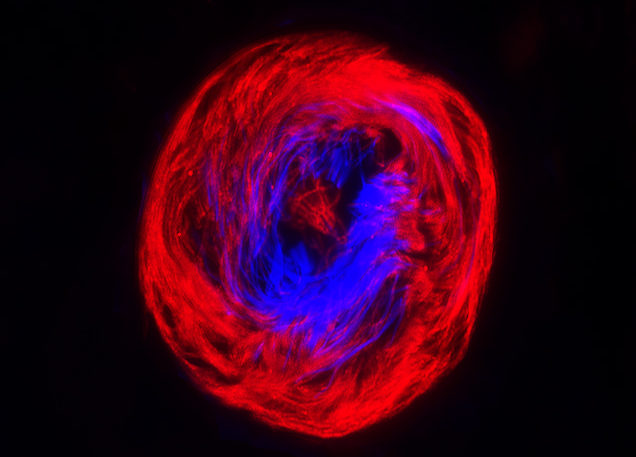A new discovery by York University researchers provides a better understanding of mosquito reproduction, which could lead to new approaches in methods to control disease-spreading mosquito populations.
The research, led by Faculty of Science PhD candidate Andrea Durant and Associate Professor Andrew Donini, was published in the Proceedings of the National Academy of Sciences USA (PNAS) and sought to examine and understand the role an ammonia channel (Aedes aegypti Ammonium Transporter protein 1, AeAmt1) plays during digestions of a protein-rich blood meal in mosquitoes that spread disease, such as Dengue fever and Zika virus.
This image shows the thousands of sperm inside the storage organ (the spermathecae) of the female mosquito after mating with a male mosquito. The blue staining shows each of the needle-shaped nuclei of sperm cells, and the red staining shows the ammonium channel (AeAmt1) that is present along the length of the sperm tails. For context, a single sperm cell is 250 micrometers in length, and the width of the storage organ in the image is only 70 micrometers

Ammonia is toxic to animals, but animals produce ammonia when they digest proteins and ammonia channels present in the cells of animals work to remove the toxic ammonia. These channels are found in all domains of life (plants, bacteria, animals) and in animals, these channels are usually present in organs involved in digestion and excretion.
“We expected to find high AeAmt1 expression in digestive and excretory organs, important sites for protein digestion, and ammonia excretion,” said Durant. “To our surprise, we found AeAmt1 most highly present in an organ called spermatheca in female mosquitoes (and many other species of insects).”
The spermathecae are organs where sperm is stored within the female mosquito after mating with a male mosquito and before egg fertilization. This finding led Durant to examine the male mosquitoes, where it was discovered that AeAmt1 is found within the sperm, specifically. Further studies demonstrated that AeAmt1 is essential for sperm survival and male fertility in these mosquitoes.
“We show that sperm of disease-vectoring mosquitoes have an ammonia channel which is important for sperm survival and the ability of sperm to fertilize eggs, which may be a feature that could be exploited for mosquito control,” said Durant. “Since sperm have a high metabolic activity, the need to rid themselves of toxic ammonia that they produce may be a general feature in sperm of all animals, and not just mosquitoes.”
This is the first time that an ammonia channel has been shown in sperm, and this channel is present throughout all stages of sperm development which may be a general feature in animals. The ammonia channel in sperm is required to keep sperm alive and able to fertilize eggs.
“Decreasing the amount of ammonia channels in the sperm of these mosquitoes reduces male sperm count, resulting in reduced fertility,” said Donini. “This may also be a common feature in sperm of other animals.”
With this knowledge, say Durant and Donini, AeAmt1 may be exploited to control populations of these disease-spreading mosquitoes.
The study “Ammonium transporter expression in sperm of the disease vector Aedes aegypti mosquito influences male fertility” was published Nov. 9.
